back to decision-makers list
For the French government, Calais is a national stage to show that it is tough on migrants and can still maintain order. From time to time, presidents and ministers visit to make a speech for the cameras. But most of the time, the government acts through its local representative, the Prefecture, which commands the Police aux Frontières (PAF) border police, and the back-up riot cops of the CRS and Gendarmerie. The Prefect also intervenes in other ways such as running the detention and deportation systems, taking direct control of land and resources, funding or obstructing NGOs, and using its political muscle to influence other key actors.
Internal structures
- politicians
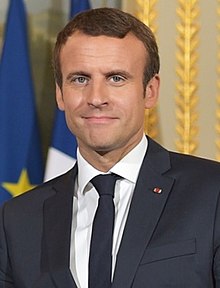
image: Macron
There are two main national elected institutions in France: the President, and the Parliament (National Assembly and Senate). The government, including the prime minister, is nominated by the President. The Interior Ministry has responsibility for migration and policing, and is similar to the UK Home Office.
The current president, Emmanuel Macron, is a former Socialist party minister who confounded tradition by winning the April 2017 election as a centrist independent. His new party, “En Marche!” also won a majority in June’s parliamentary elections. However, his grip is weakening since then, and the party failed to gain a Senate majority in September 2017.
Macron’s main rivals are the centre-left Socialist Party, the centre-right Les Republicains, and the far-right Front National (FN) led by Marine Le Pen. The Socialists formed the last, deeply unpopular, government, while Les Republicains lost the presidential elections due to corruption scandals. There is little to distinguish Macron from either of these in terms of policy (or anything else really). All three aim to make neoliberal reforms to “deregulate” Labour markets, setting up conflict with the unions. All three want to be seen as in control of the country’s order and borders, and so try to project an image of anti-migrant toughness.
All three are continually reacting to the threat from the FN, whose nationalist platform combines anti-migrant xenophobia with an appearance of support for “native” workers threatened by labour reform. The FN scored the highest vote in the presidential election, but France’s two-stage system allowed supporters of the other parties to rally behind Macron in the second round to stop Le Pen.
In terms of Calais, Macron’s election has changed nothing. Calais is used as a national stage for governments to display their “toughness” against migrants and crack down on disorder. Furthermore, the impoverished ex-industrial region around Calais is a former communist stronghold but now particularly strong for the FN. Pas-de-Calais was one of only two departments where Le Pen won an outright majority in the election’s second round.
- prefecture
A key difference from the UK model is the role of the “Prefecture”, which represents the state and carries out its orders at the local (departmental or regional) levels. The Prefect is a career bureaucrat who is appointed by the president and reports to the Interior Minister; beneath the Prefect is a “cabinet” of more junior functionaries, and a whole local bureaucracy. Prefects interact and may sometimes clash with locally elected authorities such as Mayors and the Conseils Regionales (discussed below).
There are two levels of prefects relevant to Calais: the department (Pas-de-Calais) and the region, which oversees a number of departments. As of 1 January 2016, the region is “Hauts de France”, also known as “Nord-Pas-de-Calais Picardie“, following the merger of regions Nord-Pas-de-Calais and Picardie. The departmental prefect is based in Arras, a town inland from Calais; the regional prefect in Lille.
One of the Prefect’s roles is to be in charge of policing and security. In Calais, the Prefect’s most consistent role with respect to migrants has been to command the “Chasse a l’Homme”, the coordinated police harassment of migrants in the area around Calais.
The recent Prefect of Pas-de-Calais, Fabienne Buccio, also played the leading role in the creation and then destruction of the “Jungle”. She was popularly identified as the architect of the scheme to house migrants on the state-requisitioned land outside Calais. As the political climate turned against the camp, she then organised its eviction and demolition, on the behest of central government.
The Prefecture also led, under government instruction, on the building of the “Great Wall of Calais”, and is in charge of liaising with the Port and Eurotunnel on security.
The current prefect is Fabien Soudry, who replaced Buccio in March 2017.

Fabien Soudry
- police forces
There are two national police forces in France: the Gendarmerie, technically part of the army; and the Police Nationale. The Police Nationale has a number of directorates (“Directions Centrales”) including the main uniformed police force (called “Securité Publique”), the border police Police aux Frontières (PAF), and the riot police Compagnies Républicaines de Sécurité (CRS). Both are overseen by the Interior Ministry and have their own national hierarchy. But both come under the operational command of the Prefect within their area. (The local Police Municipale are under the Mayor’s command, but have considerably less powers.)
- Police aux Frontières (PAF)
The PAF is the “directorate” of Police Nationale assigned specifically to border and immigration control. In Calais, PAF is the main anti-migrant force and generally in charge of operations, with other police forces such as the CRS and Gendarmerie drafted in as back-up “muscle”. Their headquarters is near the Eurotunnel entrance at Coquelles. PAF play a number of roles in the Calais border system including: controls inside the Port and Eurotunnel, in coordination with UK Border Force and private security; directing the “Chasse a l’Homme” against migrants in the town of Calais and the surrounding area; gathering intelligence on migrants in the area; operations against “passeurs” (people smugglers), and occasionally against “No Borders”; running the detention centre at Coquelles and deportations.
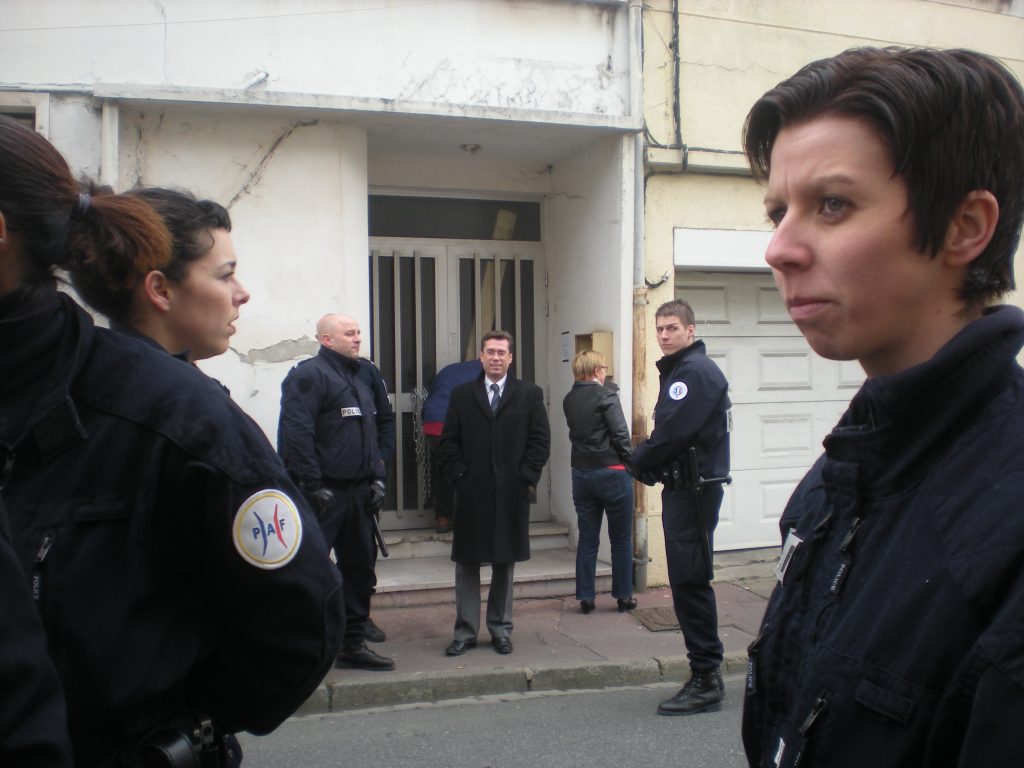
image: PAF with deputy mayor Philippe Mignonet evicting a squat in March 2013
- CRS
The CRS are the riot police units of the Police Nationale. In most of France, they are based in regional barracks and only called into action for emergency duty: Calais is one of the few places in France where CRS are on permanent duty. For several years until 2015, there was typically one company of CRS stationed in Calais making patrols and arrests under direction from PAF, with two or more companies present during special operations such as large evictions. Companies, which are based in different regions around France, would be rotated through Calais every three weeks. 2015 and 2016 saw a massive increase in CRS numbers, which now appear to be gradually receding. CRS work out of the PAF base at Coquelles and also the Police Nationale station in central Calais. They are billeted around Calais, recently in the local IBIS hotel.
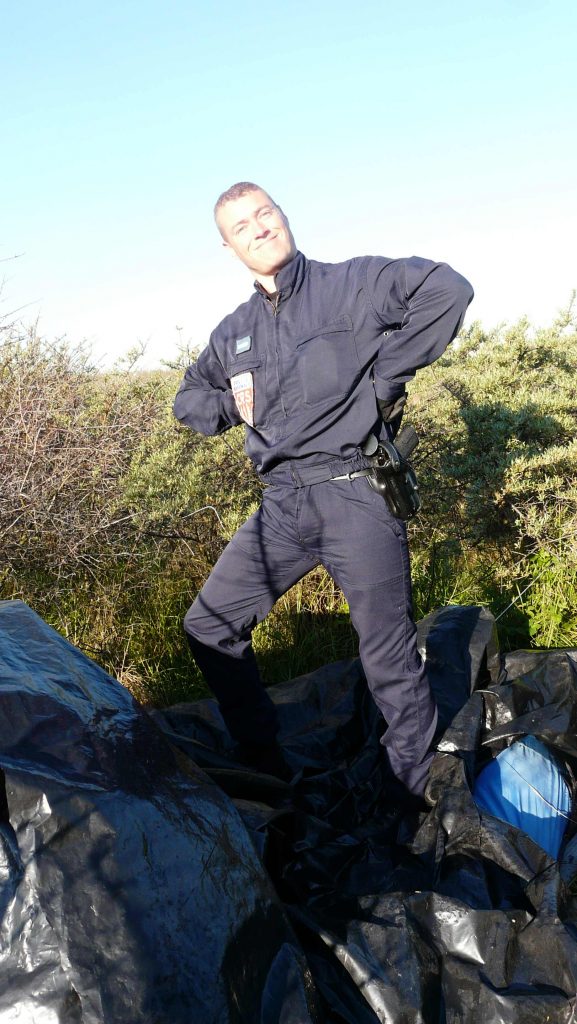
image: CRS officer poising on top of tent pulled down during raid on the “Hazara jungle” camp in 2009
- Gendarmerie
The Gendarmerie is technically part of the Army, however it is also placed under the command of the Minister of the Interior (except in some contexts), and locally the Prefecture. One section of the Gendarmerie, the Gendarmes Mobiles, are riot cops who are often deployed alongside the CRS. In Calais, until 2015 the Gendarmes Mobiles appeared only as reinforcements to the CRS for large demonstrations or moments of “unrest”. More recently, they have been used regularly to guard the new security fences near the Port, Highway and Eurotunnel, alongside the CRS.
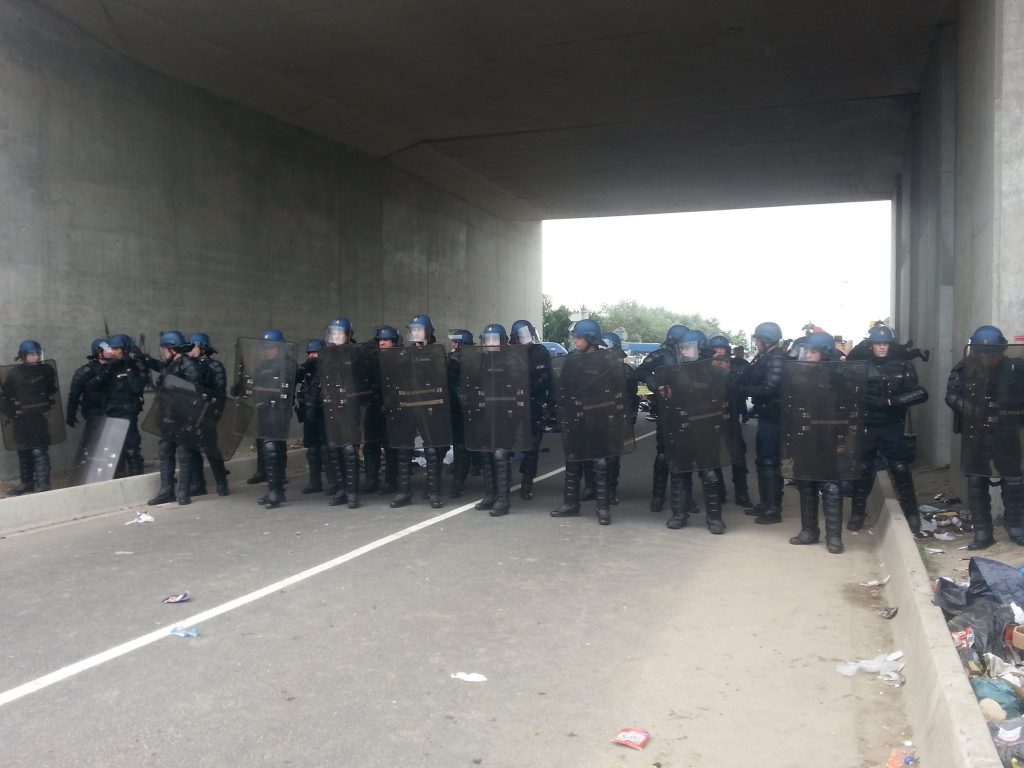
image: gendarmes mobiles block entrance to the jungle, september 2016
Motivations
- politicians
As in the UK, the “Calais migrant question” is a political issue, stoked up by media, on which politicians vie to show that they are “in control”. For British politicians, Calais stands for the dark “horde” about to break through control the frontiers. For the French, it is a zone of lawlessness, an anomaly that displays the weakness of a Government’s control over its territory. As in the UK, and even more so, the far-right plays a notable role in spreading this message and so pressuring the parties of government into action. The Front National is become a genuine electoral threat even for the Presidency.
The Government thus needs to find “solutions” which show it is taking action to regain mastery. In reality, however, these solutions are merely spectacles of force without any long-term strategy or effect. For example, the 2016 jungle evictions were panic measures by the Hollande government as its poll ratings nosedived ahead of an election; but as everyone expected, migrants began to return to Calais once again after the operation.
One obvious longer-term solution for the French government would be to break the juxtaposed control agreement. After all, the “chaos” in Calais is a direct result of this British demand. Occasionally, politicians raise this point during campaigning – as did President Macron amongst others during the last presidential elections. But no politician has made actual steps to break the deal.
- bureaucrats
The Prefect and other senior officials don’t have the same political pressure to take immediate action ahead of elections. But they will also seek to show control and competence, aiming at reputation and promotion.
- police
While many PAF and CRS officers are just “doing their jobs”, there are also a substantial number, and particularly amongst the CRS, who are (a) notably sadistic and/or (b) members of or closely linked to fascist groups. E.g., there have long been known connections between some of the northern CRS companies and far-right organisations including the “Maison de Flandres” (Flanders House). In 2016, various episodes were documented of CRS working closely with local fascist anti-migrant vigilante groups in Calais.
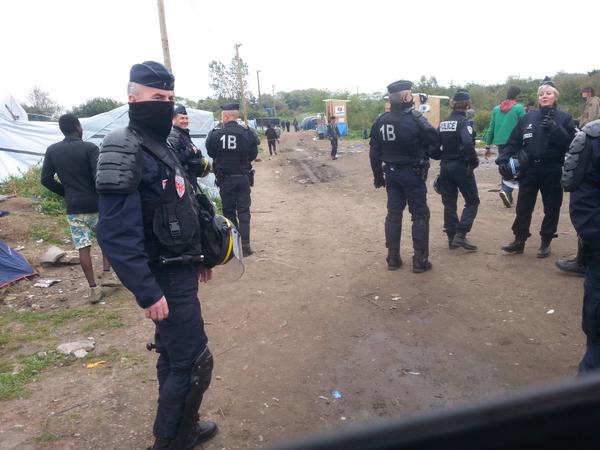
image: CRS in riot armour patrolling in the jungle
Activities in Calais
- national policy
The French government is the main body involved in dialogue with the UK government, setting up and maintaining the juxtaposed control system.
- immediate border control within port and tunnel
The PAF, working alongside UK Border Force and private security, have immediate responsibility for the French side of the border checkpoints in the Port and Tunnel. Some of these functions can also be delegated to CRS and other forces, e.g., CRS and Gendarmes Mobiles are used to guard the perimeter fences and may be mobilised in large numbers in the case of major incursions or attempts.
- intelligence and anti-smuggling operations.
PAF gather “intelligence” on migration routes, movements, etc. They have investigative divisions targeting smuggling, which can include under covers and paid informers amongst migrant groups. As well as targeting smugglers, PAF have occasionally targeted solidarity campaigners and “No Borders”.
- detention and deportation
The PAF are responsible for processing arrested migrants. Prisoners caught by UK Border Force or private security in the Port or Tunnel are handed over to them; they also take their own prisoners in the “Chasse a l’Homme” around Calais. Prisoners are typically taken first to the short term cells in their base at Coquelles, near the Eurotunnel; they may then be transferred to the longer term detention centre which is in the same complex. Typically, most migrants brought to Coquelles will be released within a few hours or days, perhaps with a document called an “order to quit the French territory” (OQTF) paperwork. Some may be held for deportation. There is a pattern of the Prefect ordering round-ups of particular nationalities to carry out largely symbolic mass deportations by charter flight.
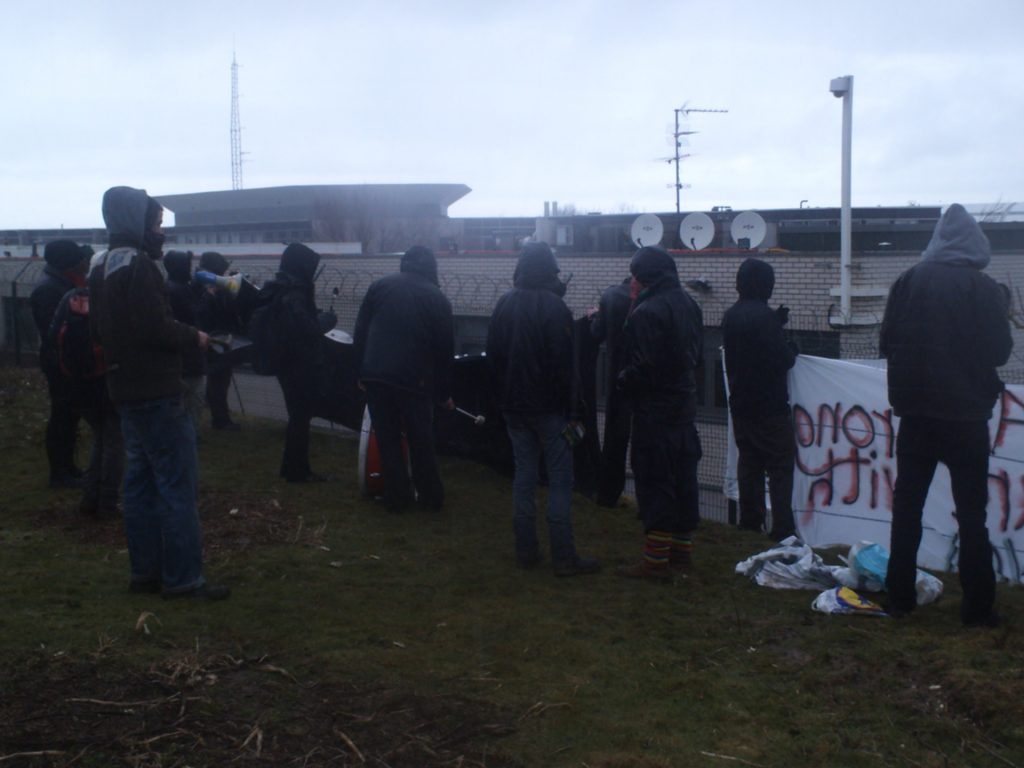
image: a solidarity demo at the Coquelles detention centre in 2012
- the “Chasse a l’Homme”: policing of migrants in the area
Until 2015, the main activity of PAF and CRS was to carry out a continual series of patrols and raids against migrant dwellings in and around Calais, and migrants found in the streets or public areas. This meant arresting people, who were typically released a few hours after, destroying dwellings and belongings, and otherwise making life hell. As Calais Migrant Solidarity analysed in a 2012 report, the aim appeared to be to create a regime of misery for migrants in the area, so perhaps persuading people to leave the vicinity, and dissuade others from coming.
With the dramatic increase in migrant numbers in 2015 and 2016, the policing focus shifted somewhat to guarding the security fences at the Port, Tunnel, and Highway from large scale incursions. Migrants were contained within the newly established “Jungle”; attempted settlements anywhere else were swiftly destroyed, but otherwise people were typically left unmolested passing through the town and vicinity.
After the destruction of the jungle, the main policing focus is on preventing new settlements from forming, reverting to the pre-2015 pattern of enforced precariety and systematic harassment.
- asylum system
The government grants asylum to some refugees in Calais, allowing them to become “regularised”. Most migrants in Calais initially hope to reach the UK. But many become stuck, sometimes for years, and may then decide to try and stay in France instead. France accepts roughly the same proportion of asylum claimants as the UK, and many of the nationalities typically present in Calais have a decent chance of being accepted. However, the waiting times in France are long, and accommodation and support for asylum seekers notoriously poor: e.g., many asylum seekers have also preferred to stay in jungles and squats rather than official asylum hostels (“foyers”), and in any case there are often no places available. The NGO “France Terre d’Asile” has a contract which involves giving asylum information to migrants in Calais.
- funding and management of NGOs
The state intervenes in the lives of migrants through NGOs which it registers, monitors, and in some cases funds. Before 2015, official non-policing contact with migrants was fairly minimal. It involved mainly the daily charity food distributions run by the local NGO “Salam” and others, which were in part state funded; and the winter accommodation space under the national homeless “Plan Grand Froid”, open only in extreme cold conditions.
It increased dramatically in 2015-16, when the charity La Vie Active was paid to run the “Jules Ferry” day centre which included food distribution, access to medical and other facilities, and some accommodation for women and children (a role the state took over from “No Borders” who had maintained the squatted Victor Hugo “women’s house”.) The Jules Ferry centre thus became a major service hub and contact point for migrants in Calais, before expanding its role still further as the site of the permitted “jungle”. La Vie Active received direction from the Prefecture, becoming effectively a proxy for the state in its everyday interaction with migrants. (Academics might say that the government of migrants in Calais moved from a “disciplinary” to a more “biopolitical” relationship, for a while.)
Since the end of the jungle, the relationship has swung right back to being one of simple police violence, as currently the state tries to deny even the presence of migrants of Calais and block any provision of services, e.g., trying to shut down even the minimal shower service provided by the very mainstream “Secours Catholique” charity.
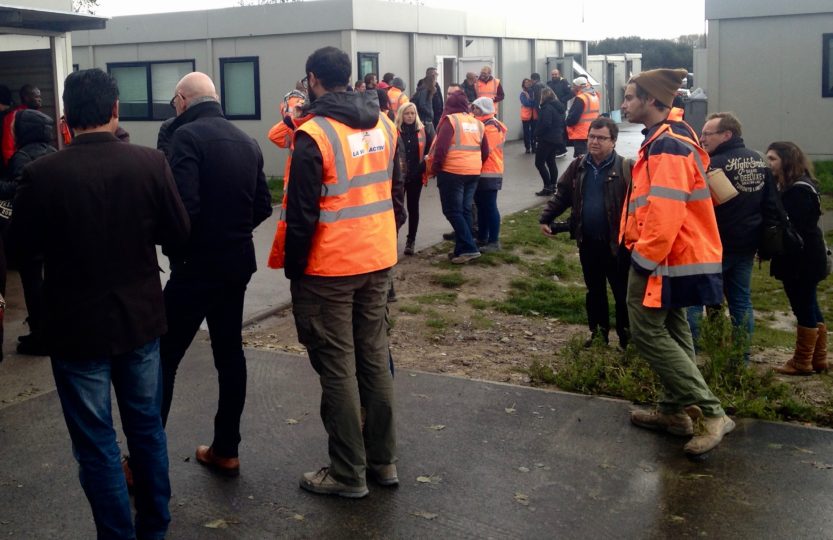
image: La Vie Active staff
- the Jungle: creation, supervision, destruction of migrant dwelling
The “Calais Jungle”, demolished in October 2016, was a state attempt to contain migrant settlement into one tolerated, even facilitated, site outside the town centre. The land, part contaminated industrial wasteland and part scrubland frequented by hunters, had been owned by the Conseil Regional. It was outside the power of the Mayor of Calais, who strongly opposed a permitted migrant settlement. The State arranged the purchase of the site by an environmental quango called “Conservatoire des sites du littoral”, anticipating a right wing victory in the Conseil Regional elections. The Conservatoire licensed the use of the land to the Prefecture for six years.
In 2016, part of the site became a new official “container camp”, also run by La Vie Active: the first offically provided migrant accommodation in Calais since the closure of the Red Cross Sangatte camp in 2002. In the “informal” town that grew up beside it, the state provided minimal infrastructure including water, toilets, and street lighting. This was overseen by another state-backed NGO, Acted, which acted effectively as the Prefect’s proxy inside the jungle. Acted was also instrumental in creating a “migrant council” which sought to identify and work through “community leaders”.
- environs, highway
While Calais town itself is the fiefdom of the Mayor, the government has direct control over much of the area around the town, including key transport and other infrastructure. In particular, the security zone around the Port and Tunnel, and the Highway, are securitised and maintained by the state and its contractors.
Relations with other actors
Contractors and other relations
back to decision-makers list
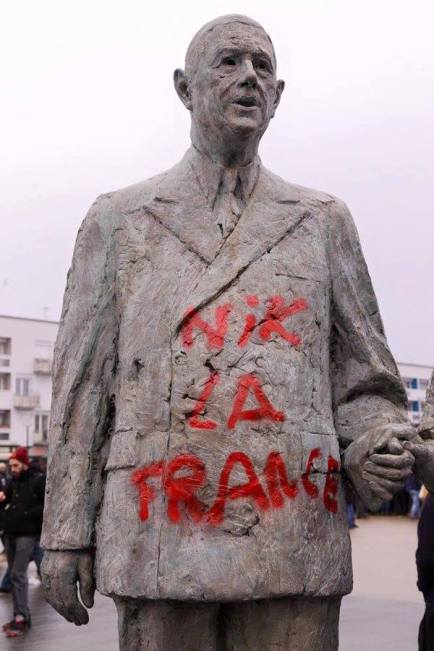
image: statue of iconic president Charles de Gaulle in Place d’Armes, Calais, graffitied with “fuck france”
